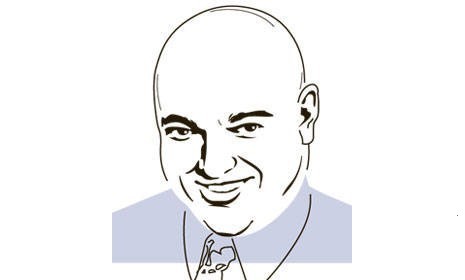Is the GOP presidential field a Tea Party failure?
To the dismay of many in the clamorous grassroots, the Republican nominee is all but certain to be an establishment insider


More than a year ago, the Tea Party capped an incredible 18-month run with a historic midterm election that took a whopping 68 House seats away from the Democrats, and handed the speaker's gavel to Republican John Boehner. No party had lost more seats in a midterm election in 72 years. While that outcome didn't surprise many activists in the Tea Party movement, it certainly appeared to catch many others off guard.
Now the shoe seems to be on the other foot. Fourteen months after that singular achievement, the Republican field for the presidential nomination seems to have no real Tea Party candidate representing the grassroots movement's iconoclastic, anti-establishment spirit. Instead, four of the leading candidates represent the Republican establishment, while the fifth has his own personal grassroots movement supporting his candidacy.
Judge the Tea Party's strength by the way in which its priorities drive this election cycle.
The Week
Escape your echo chamber. Get the facts behind the news, plus analysis from multiple perspectives.

Sign up for The Week's Free Newsletters
From our morning news briefing to a weekly Good News Newsletter, get the best of The Week delivered directly to your inbox.
From our morning news briefing to a weekly Good News Newsletter, get the best of The Week delivered directly to your inbox.
The front-running Mitt Romney, for instance, has been running for president for more than four years now, and his track record as governor of Massachusetts includes a health-care reform law uncomfortably close to ObamaCare — yes, the same ObamaCare that fueled the growth of the Tea Party in the first place. Newt Gingrich and Rick Santorum spent years in Republican leadership in Congress. Rick Perry has been the top Republican in Texas for a decade, and recently served as chair of the Republican Governors Association, a key post in the GOP establishment. Only Ron Paul has had no leadership role in the Republican establishment, but he's also had no accomplishments in Congress after spending much of the last four decades in Washington D.C.
It's not as if the Tea Party didn't have its opportunities. Many anticipated that Sarah Palin would run for president, but she demurred — and has yet to endorse one of the current candidates. Some wanted to see the blunt-speaking governor of New Jersey, Chris Christie, jump into the race, but Christie took a pass and endorsed Romney. The field did, for a time, include Herman Cain, who has been involved for years with the Tea Party and other conservative grassroots efforts, but who stumbled late in 2011. Rep. Michele Bachmann has a standing in the Tea Party movement nearly equal to that of Palin, and had at one point challenged for the polling lead in the race. But she faded into last place well before the Iowa caucuses.
Does this mean the Tea Party failed in 2012? It's easy to believe that, and clearly, one can't coherently make an argument that this field represents a true Tea Party victory. However, to call it a failure is a misreading of the way grassroots movements grow, and perhaps an example of observers and analysts trying to build a narrative in the short term that simply doesn't fit into that time frame.
Consider the impact of the New Left movement in the 1960s. Originally outside of the two-party paradigm, the rise of the New Left created a rift among Democrats during the Vietnam War that led to their disastrous 1968 convention in Chicago and resulted in the election of Richard Nixon, and then his re-election in 1972. The New Left's absorption into the Democratic Party took years — and arguably, didn't produce a legitimate presidential nominee until Barack Obama, 40 years after the Chicago convention. It took that amount of time to elect New Left candidates as state legislators, U.S. representatives and senators, and build the seniority and clout to take over the establishment of the Democratic Party, and in many cases, replace moderate Democrats in Congress as well as Republicans.
A free daily email with the biggest news stories of the day – and the best features from TheWeek.com
During those decades, the advocates and activists in this movement maintained pressure on the Democratic Party. They launched think tanks, moved into the leadership of unions, and went into "community organizing," which is how our current president got his start in politics. They changed the popular culture and media to help make their views more mainstream. Instead of fighting the establishment, the New Left eventually became the establishment in the Democratic Party — so much so that Democrats founded the Democratic Leadership Council in the late 1980s that tried to pull the Democratic Party back to the center, and ended up promoting Bill Clinton for the nomination in 1992 for that very purpose.
The Tea Party got off to a much better and less divisive start in fighting the Republican establishment than the New Left did with the Democratic Party in the 1960s. After less than two years, and without the platforms of academia and the entertainment industry for support, the Tea Party has dozens of House members and a handful of senators beholden to it. Thanks to a few effective anti-incumbent electoral efforts, the Republican establishment has developed at least a healthy respect for Tea Partiers' grassroots power. However, it will take at least a few more cycles for Tea Party–backed elected officials to grow in number and seniority, which will produce an evolution in the Republican Party — and more Tea Party–style candidates with the requisite experience and support to make legitimate runs for the presidency. Instead of judging the Tea Party on the specific candidates produced by the Republican Party less than two years after the movement began, judge the Tea Party's strength by the way in which its priorities drive this election cycle. In that sense, it's quite clear that the movement is alive and well.
Edward Morrissey has been writing about politics since 2003 in his blog, Captain's Quarters, and now writes for HotAir.com. His columns have appeared in the Washington Post, the New York Post, The New York Sun, the Washington Times, and other newspapers. Morrissey has a daily Internet talk show on politics and culture at Hot Air. Since 2004, Morrissey has had a weekend talk radio show in the Minneapolis/St. Paul area and often fills in as a guest on Salem Radio Network's nationally-syndicated shows. He lives in the Twin Cities area of Minnesota with his wife, son and daughter-in-law, and his two granddaughters. Morrissey's new book, GOING RED, will be published by Crown Forum on April 5, 2016.
-
 West Africa’s ‘coup cascade’
West Africa’s ‘coup cascade’The Explainer Guinea-Bissau takeover is the latest in the Sahel region, which has quietly become global epicentre of terrorism
-
 Daddy Pig: an unlikely flashpoint in the gender wars
Daddy Pig: an unlikely flashpoint in the gender warsTalking Point David Gandy calls out Peppa Pig’s dad as an example of how TV portrays men as ‘useless’ fools
-
 Codeword: December 3, 2025
Codeword: December 3, 2025The daily codeword puzzle from The Week
-
 Has Zohran Mamdani shown the Democrats how to win again?
Has Zohran Mamdani shown the Democrats how to win again?Today’s Big Question New York City mayoral election touted as victory for left-wing populists but moderate centrist wins elsewhere present more complex path for Democratic Party
-
 Millions turn out for anti-Trump ‘No Kings’ rallies
Millions turn out for anti-Trump ‘No Kings’ ralliesSpeed Read An estimated 7 million people participated, 2 million more than at the first ‘No Kings’ protest in June
-
 Ghislaine Maxwell: angling for a Trump pardon
Ghislaine Maxwell: angling for a Trump pardonTalking Point Convicted sex trafficker's testimony could shed new light on president's links to Jeffrey Epstein
-
 The last words and final moments of 40 presidents
The last words and final moments of 40 presidentsThe Explainer Some are eloquent quotes worthy of the holders of the highest office in the nation, and others... aren't
-
 The JFK files: the truth at last?
The JFK files: the truth at last?In The Spotlight More than 64,000 previously classified documents relating the 1963 assassination of John F. Kennedy have been released by the Trump administration
-
 'Seriously, not literally': how should the world take Donald Trump?
'Seriously, not literally': how should the world take Donald Trump?Today's big question White House rhetoric and reality look likely to become increasingly blurred
-
 Will Trump's 'madman' strategy pay off?
Will Trump's 'madman' strategy pay off?Today's Big Question Incoming US president likes to seem unpredictable but, this time round, world leaders could be wise to his playbook
-
 Democrats vs. Republicans: who are US billionaires backing?
Democrats vs. Republicans: who are US billionaires backing?The Explainer Younger tech titans join 'boys' club throwing money and support' behind President Trump, while older plutocrats quietly rebuke new administration
